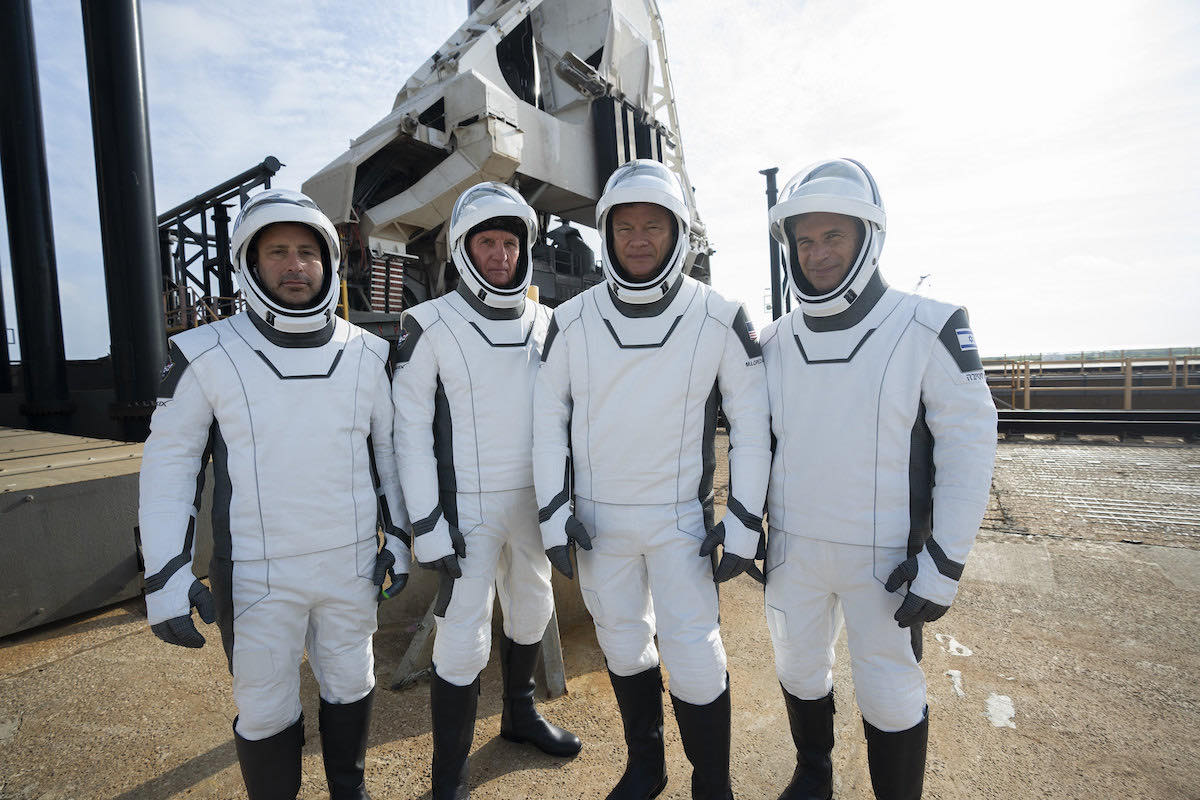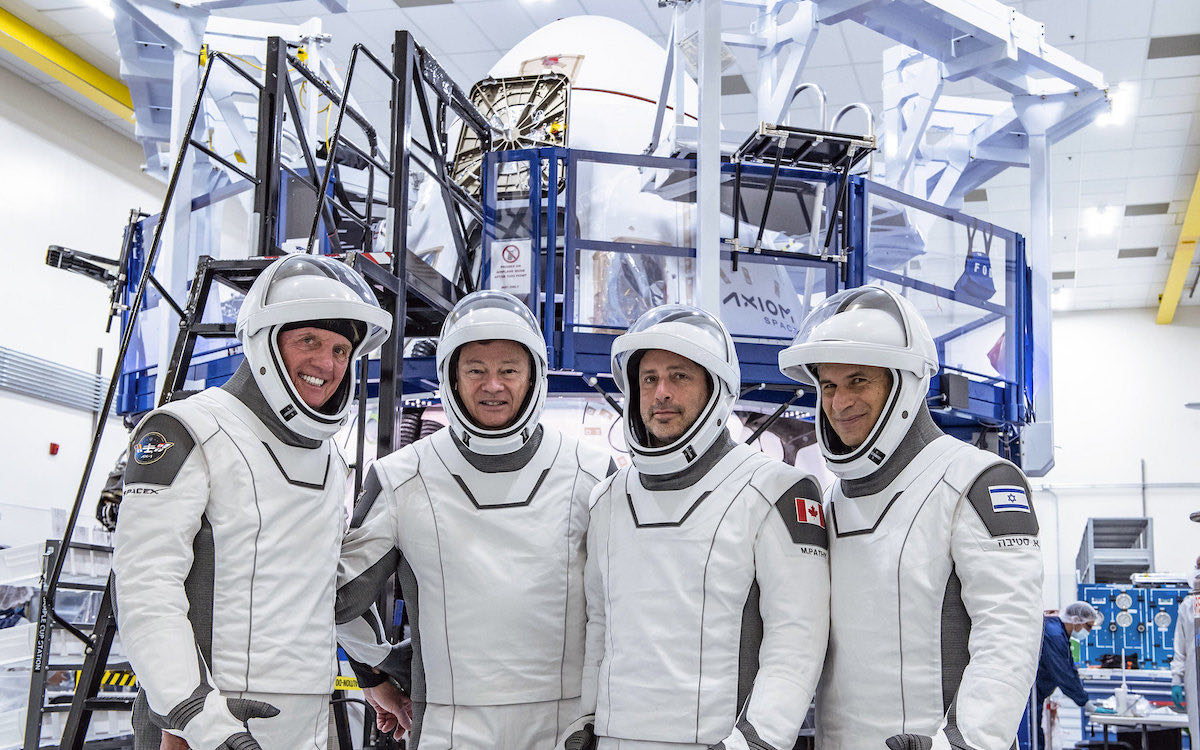STORY WRITTEN FOR CBS NEWS & USED WITH PERMISSION

SpaceX and a Houston company are gearing up to launch four private citizens Friday on the first NASA-sanctioned, fully commercial flight to the International Space Station, a key step in a government push to encourage private-sector development on the high frontier.
Mission commander Michael López-Alegría, a former NASA astronaut and now a vice president with Houston-based Axiom Space, along with entrepreneur-philanthropists Larry Connor, Canadian Mark Pathy and Israeli Eytan Stibbe plan to blast off from pad 39A at the Kennedy Space Center at 11:17 a.m. EDT Friday.
Forecasters predicted an 80 percent chance of acceptable launch-site weather, but SpaceX said it was monitoring conditions along the Falcon 9’s northeasterly trajectory where the crew could be forced to ditch in a launch emergency.
“All systems are looking good for tomorrow’s Falcon 9 launch of the @Axiom_Space Ax-1 mission to the @space_station,” SpaceX tweeted. “Teams are keeping an eye on downrange weather along the ascent corridor.”
The Axiom 1 mission, or Ax-1 for short, will mark the sixth piloted launch of a SpaceX Crew Dragon capsule, the second fully commercial flight to orbit after the privately financed Inspiration4 mission last September and the first all-commercial visit to the International Space Station.
While 11 private astronauts, or “space tourists,” have visited the space station over the past two decades under commercial arrangements with the Russian space agency, they were all accompanied by professional cosmonauts. The Ax-1 crew is the first all-commercial non-government flight to the station and the first sanctioned by NASA.

Opening the space station to commercial use is part of a push by NASA to facilitate private-sector operations in low-Earth orbit and to encourage development of commercially operated research stations after the ISS is retired in the 2030 timeframe.
So far, Axiom Space has booked three private astronaut missions through SpaceX and is designing modules that will be attached to the station for commercial use. Before the lab is retired, a solar power and cooling system will be added so the Axiom modules can be disconnected to fly on their own as an independent outpost.
“This is a historic mission for two reasons,” said Axiom CEO Mike Suffredini, a former NASA space station program manager. “This is the first completely private mission to the International Space Station. In addition to that, Axiom Space was founded to build a commercial space station, the first module will launch in a little over two years from now.
“But this is our very first mission of probably hundreds of missions to come over the next several decades as we build the Axiom space station and provide services in low-Earth orbit for many decades to come.”
Assuming an on-time takeoff, López-Alegría and Connor, a veteran private pilot, will monitor an automated 20-hour rendezvous and approach to the space station, moving in for docking at the forward Harmony module’s space-facing port around 7:45 a.m. Saturday.
Standing by to welcome them aboard will be station commander Thomas Marshburn, Raja Chari, Kayla Barron and German astronaut Matthias Maurer, launched aboard a Crew Dragon last November. Also on hand: Russian cosmonauts Oleg Artemyev, Denis Medveev and Sergey Korsakov, who arrived at the lab last month aboard a Soyuz spacecraft.

López-Alegría is a veteran of four space flights, including a long-duration stay on the station, logging a cumulative 257 days off planet before retiring from NASA in 2012. He received refresher training for the Ax-1 mission and serves as a mentor to his rookie crewmates.
Connor is a “non-profit activist investor” and founder of the Connor Group, a real estate investment firm managing $3.5 billion in assets. He is an acrobatic pilot, off-road racer and mountaineer. Pathy is an investor/philanthropist, chairman and CEO of a Montreal-based investment and finance company.
Stibbe flew F-16 jets in the Israeli air force, later serving in the reserves while building a successful business career. During active duty, he served under Ilan Ramon, who lost his life in the Columbia shuttle disaster after becoming the first Israeli in space.
“He was a good friend, he was my commander in the squadron and I had the opportunity to visit him during his training in Houston,” Stibbe said. “Since then, we stayed in a very close relationship with his wife, with the children, and I will take with me … a copy of the diary that survived that crash, the diary that Ilan wrote on board Columbia during the spaceflight.
“Some of the pages survived the crash. I will take copies of these pages with me. I’ll take a song written by his son and a beautiful painting by his daughter of pages falling out of the sky.”
The Axiom-1 crew plans to spend a little more than a week aboard the lab complex carrying out a variety of commercially-sponsored bio-medical experiments, technology demonstrations and outreach before undocking and returning to Earth with splashdown in the Atlantic Ocean or the Gulf of Mexico, depending on the weather.
The cost of the Ax-1 mission is not known. SpaceX advertises the price of a Falcon 9 rocket at around $60 million, but that doesn’t include the use of a Crew Dragon capsule, crew training and the around-the-clock support required for a human spaceflight. NASA’s inspector general has estimated the average cost of a Crew Dragon seat at around $55 million.
Axiom Space paid for the Ax-1 flight, covering the cost of López-Alegría’s seat. His crewmates, or their representatives, purchased their “tickets” from Axiom. The company also bought NASA-mandated insurance and hired a private contractor, Operator Solutions of Melbourne, Florida, to provide rescue services in case of a launch abort.
For Crew Dragon flights carrying NASA astronauts, the space agency relies on the Department of Defense and personnel with Detachment 3, a unit within the 45th Space Delta at Patrick Space Force Base, to orchestrate a global response and rescue of astronauts aboard a downed spacecraft.
That option is not available for non-government missions. Instead, Operator Solutions, using veteran military and civilian rescue personnel, will provide emergency response support for the Ax-1 crew along the ship’s trajectory up the East Coast of the United States during the climb to orbit.

Because of the high cost of spaceflight, civilian fliers, or space tourists, are typically millionaires or even billionaires who can afford to indulge in pursuits that are far beyond the reach of the average person. But López-Alegría said his crew, and their research-loaded mission, so not fit the standard space tourist profile.
“I think there is a place for space tourism, it’s just that’s not what this mission is about,” he said in an interview with CBS News. “This is something that is the full monty, the full experience.”
Connor agreed, telling reporters “we’ve spent anywhere from 750 to over 1,000 hours training. Additionally, across all of the astronauts here, we’re going to do some 25 different experiments encompassing over 100 hours of research (while) we are on the ISS.
“I think I speak for all of us that we understand this first civilian mission (is) a big honor and a big opportunity. But with that comes a big responsibility, and that is to execute the mission correctly and successfully.”
But they’ll no doubt do a bit of sightseeing amid their research and enjoy meals prepared by celebrity chef José Andréas, a friend of Madrid-native López-Alegría.
For their first meal in space, the Ax-1 crew “will enjoy Arroz Estelle Valencia, a classic Spanish rice dish,” Axiom Space said in a release. “Later in the mission, the crew will eat Secreto de Cerdo with Pisto, a prized cut of Ibérico Pork with tomatoes, onions, eggplant, and peppers, and Chicken and Mushroom Paella, Spain’s quintessential rice dish.”
from Spaceflight Now https://ift.tt/4KSYrg5
via World Space Info







0 comments:
Post a Comment